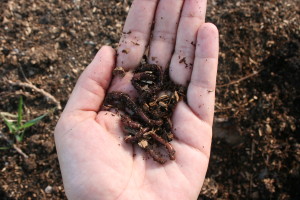
A few weeks ago we’ve learned the basics of Thermophilic Compost from Frog Hollow’sFarms very own micro-biologist, Christophe. This week we’re to add a little somethin’ special to compost: WORMS!
Vermicompost, or compost made with worms, is very powerful Think of worms as little compost reactors that kick composting it into high gear. While you might be imagining grey earthworms they are too solitary and cold-loving for compost Luckily, the Red Wiggler worm is up to the task. Named for the way they thrash around when disturbed, Red Wigglers live happily in large groups under the leaf litter, or duff, that covers the forest floor and can tolerate some heat. Our farm’s “waste” provides top-notch food for the worms to break down so that microbes can feed on it and in turn kill the same pathogens that could detrimentally affect our trees. Everybody wins!
Many of our worms start off their lives in a horse-barn-turned-worm-barn on the edge of the orchard. Jokingly referred to as the “crocodiles pits” Christophe lovingly raises worms on a diet of tree trimmings, kitchen scraps, shredded paper, and waste from some of our neighbors at the Ferry Building including mushroom logs from Far West Fungi, juice pulp and LOTS of coffee grounds. The worms love the coffee grounds which are high in nitrogen, a nutrient also very important for our trees. These worms are then used to populate new 100 foot rows of fresh compost outside. It takes about 2-6 months for the worms to break down the piles sufficiently. Christophe estimates that we have 5-10 million worms in our vermicompost beds alone.
Vermicompost is so concentrated that use it to make “tea” for our trees but Christophe does not recommend bringing biscuits to this tea party! It only takes five lbs of vermicompost soaked in 300 gallons of water overnight to make the a wonderful natural fertilizer, full of probiotics and nutrients that can be sprayed directly on to the trees. Just like us, the trees absorb things to put on their “skin”. Applying nutrients to a plant like this called foliar fertilization. It gives the plants a quick, healthy dose of what they need to grow, right where it is needed most. Right now that means right on the buds that will form fruit later this year. Compost tea also helps populate the tree’s microbiome with beneficial micro-organisms to help ward off disease. Compost applied to the soil beneath the tree takes a longer time to reach the branches of the tree but can provide a more sustained application during the growing season so we use both so that our trees get support year rou
nd!

 Follow
Follow
